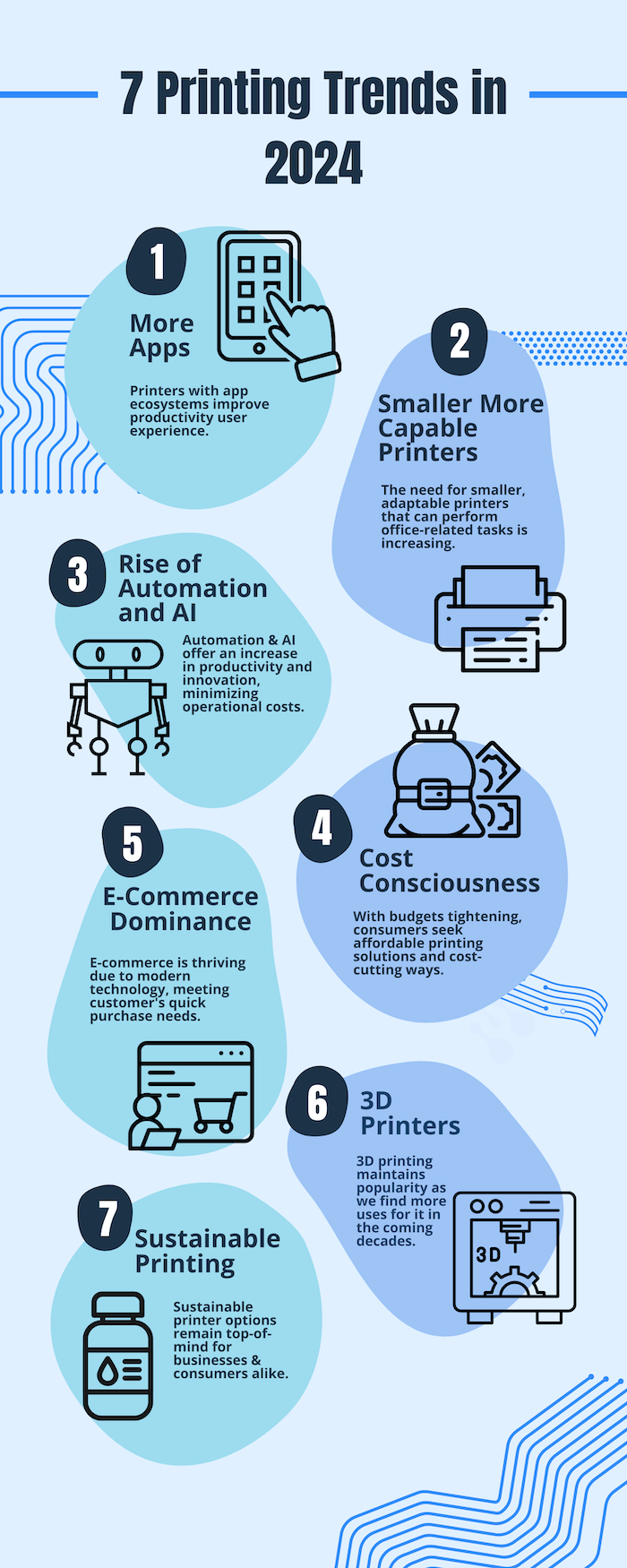
Printing is still integral to various industries, including education, healthcare, and legal services. From medical records to legal documents, there are several situations where physical copies are needed to ensure their authenticity and reliability. Moreover, with the advancement of printing technology, printers have become more than just printers; they are now more efficient, user-friendly, and more intelligent than ever before, equipped with technology like that used in phones and computers.
In this dynamic landscape, businesses must keep up with emerging trends to facilitate and improve their productivity.
At Strategic Technology Partners of Texas (STPT), we take pride in being at the forefront of technological innovation, providing cutting-edge solutions to our clients. As experts in the field, we have identified seven key trends shaping the printing landscape in 2024.
So, whether you're a business owner, an entrepreneur, or an individual consumer, this article is for you. In the following sections, we'll delve into these trends, offering insights and analysis to help you navigate the evolving printing ecosystem. Let's dive in!

Top 7 Trends in the Printer Industry
1. Apps
The year 2024 sees a growing trend of integrating applications with printers. In recent years, apps have become a crucial aspect of the printing experience. Users want to easily access printer functions from both their computers and mobile devices. Printers with app ecosystems offer more advanced features, allowing users to simplify their workflows, access cloud-based storage, and perform editing tasks directly from their machines.
Xerox, for instance, offers Workflow App customization, enabling customers to create tailored Workflow apps for their business needs. Combining printing and app technology improves productivity, promotes collaboration, and facilitates remote printing for today's hybrid workforces. Some examples of printer app offerings include:
- The Canon PRINT Business App enables users to print, scan, copy, and send jobs with their smartphone or tablet without touching the control panel.
- Epson's Amazon Kindle Fire Tablet Printing app allows users to print wirelessly from their Kindle tablet to a nearby printer. Users can print documents, PDFs, photos, emails, web pages, and other content at home or in the office.
- The Xerox App Gallery has the most robust app selection of the vendors. With industry-specific apps like Xerox Note Converter for business and Remark Test Grading for education.
If you want to boost your office's productivity, check out our blog post on the 6 essential Xerox printer apps.
2. Smaller Printers with More Office-like Functions
With more and more workplaces downsizing and moving towards hybrid workflows, there is a growing demand for smaller, versatile printers that can fulfill office-like functions. These compact printers offer features such as scanning, copying, and faxing capabilities, making them an all-in-one solution for small businesses and home offices. Not only do these space-saving devices optimize office layouts, but they also provide cost-effective alternatives to pricier equipment.
As the workspace transitions to remote, the need for flexible copiers that fit into smaller spaces will only grow. Below are examples of smaller A4 machines that pack a punch with powerful multifunction capabilities.
- Xerox C315 Color Multifunction Printer
- HP Color LaserJet Pro MFP 4301fdw Wireless Printer
- Canon Color imageCLASS MF753Cdw
- Epson WorkForce Pro WF-C5890 Color MFP
3. Automation and AI
Artificial Intelligence (AI) and automation are increasingly becoming a part of the printing industry. They are replacing repetitive tasks such as file management and maintenance in printing devices.
Xerox Robotic Process Automation (RPA) uses AI-powered algorithms to optimize print workflows, improve print quality, and reduce operational costs. By leveraging AI and automation, businesses can increase their efficiency, minimize downtime, and find new opportunities for innovation.
HP's Indigo Series printing presses have an inline inspection system, Automatic Alert Agent 2.0, that uses AI and machine learning to detect defective sheets. This inspection system scans and compares every printed sheet to its digital reference, automatically identifying print defects.
4. Cost-Consciousness
In today's world, where inflation is rising, and budgets are getting tighter, consumers are constantly looking for more affordable printing solutions. There is an increasing demand for printers that offer value without compromising performance or quality.
At STPT, we have noticed a growing trend among our customers this past year. Due to budgetary concerns, they are increasingly inquiring about affordable printers, such as smaller A4 machines.
Expert Tip: Understanding your print volume is essential before purchasing any printer.
More and more businesses are turning to managed print services to reduce costs. Typically, a printer vendor evaluates their clients' existing printer fleet and suggests ways to print more efficiently by updating devices and using fewer of them. Businesses can save money in the long run by monitoring key metrics such as toner usage, color print quantity, and cost-per-print. At STPT, we provide a managed print services package called e-valet that includes a comprehensive assessment of your printing needs.
If you'd like to know whether managed print services are right for your business, read our blog on its pros and cons.
5. E-Commerce for Configuring and Purchasing
The printing industry is increasingly embracing e-commerce and adapting to how users want to buy printers. This shift is driven by the desire of both customers and businesses to find printing solutions that cater to their unique preferences and objectives. With the help of modern technology, customers can now use interactive tools that allow them to configure their purchases in minutes. They can easily find the price of the printer they want and even add finishing options with just a click of a button.
At STPT, we value the importance of personalization for our customers. That's why we have added a product configurator to our website that allows customers to select the printer model with their desired features and capabilities. By prioritizing the needs of our customers, we can offer tailored products that meet their requirements, leading to greater engagement and brand loyalty.
6. 3D Printers
It's no secret that 3D printers have taken the world by storm, revolutionizing industries left and right. These devices have become a hot commodity from engineering and education to government and healthcare. And it's not hard to see why. With unparalleled flexibility and innovation in product design and prototyping, 3D printers are paving the way for a new era of creativity and productivity.
However, some 2D printing companies still hesitate to fully embrace 3D printers due to economic uncertainty. Nonetheless, interest in 3D printing will only rise in the coming decades as we find more ways to utilize the output.
In May last year, HP announced new automation solutions for their JetFusion 3D printer line to help customers scale their 3D print production.
7. Sustainable Printing
On every major printer manufacturer's website, you will undoubtedly see a section on sustainability. Environmentally conscious printer options are increasingly top-of-mind for businesses and consumers alike. This has led to a rise in adopting eco-friendly printing practices and materials.
Eco-friendly printers use recycled paper, biodegradable inks, and energy-efficient technologies to minimize their ecological footprint. By adopting sustainable printing practices, businesses can reduce waste and emissions, improve their brand reputation, and attract environmentally conscious consumers.
Epson recently announced its decision to completely abandon the production of laser printers and switch solely to inkjet printers by 2026. On the other hand, HP introduced their TerraJet toner cartridges in March 2023, designed to use 78% less plastic in their packaging and up to 27% less energy than regular toner cartridges.
Besides, Xerox, HP, and Ricoh are also implementing measures to reduce the environmental impact of office waste by engaging in ongoing forest conservation efforts.
As consumers become increasingly conscious of their environmental impact, they are also looking for printers that are built to last. Printer manufacturers must rise to this challenge and find innovative solutions that meet this growing demand.
Stay Ahead in Printing
As we move forward into the constantly evolving printing industry of 2024, it is evident that innovation and adaptation are essential to stay ahead of the competition. From apps and AI to sustainability and e-commerce, the future of printing is full of possibilities, and we are here to support you every step of the way.
At STPT, we are passionate about helping our clients take advantage of the most up-to-date printing trends and technologies to meet their business goals. Stay tuned for more information and updates as we continue to examine and analyze the world of printers.
If you want to learn about cutting-edge printing solutions and how they can help your business, please contact us. Our business consultants are available to provide industry insights and help you find a solution tailored to your specific needs.
Ready to find your perfect printer? Visit our product configurator page by clicking on the image below and choose the features and capabilities that best suit your needs.
